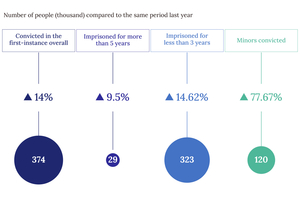In Depth: Rural China Suffers a Teen Mental Health Crisis
Listen to the full version
A new comprehensive report sheds light on the mental health challenges facing adolescents in rural China, a population that includes millions of “left-behind children.”
The term “left-behind child” refers to a rural child under 18 whose parents work away from home for at least six months, preventing them from living together. According to a 2023 report from the National Bureau of Statistics, about 10.9 million such children were enrolled in China’s compulsory education system in 2022.

Unlock exclusive discounts with a Caixin group subscription — ideal for teams and organizations.
Subscribe to both Caixin Global and The Wall Street Journal — for the price of one.
- DIGEST HUB
- About 10.9 million "left-behind children" in rural China face high mental health risks, with 21.5% at mild and 8.1% at high risk of depression.
- Smartphone dependency is widespread; 46.1% of surveyed rural middle schoolers cannot tolerate being without a phone, correlating with higher depression and anxiety.
- Systemic issues like weak family support, poverty, and lack of mental health professionals exacerbate challenges, with only part-time counselors in most rural schools.
A recent in-depth report highlights the grave mental health issues faced by adolescents in rural China, paying particular attention to “left-behind children” — those whose parents are long-term migrant workers. These youth, numbering about 10.9 million in the compulsory education system as of 2022, exhibit increased risks for depression, academic struggles, psychological trauma, behavioral problems, and lower resilience compared to their urban counterparts, as revealed by a 2024 survey involving 13,992 students from 18 poor counties across nine provinces. Notably, 21.5% of the sampled rural children screened at mild risk of depression and 8.1% at high risk, underscoring the widespread nature of these challenges[para. 1][para. 2][para. 3].
Systemic shortcomings exacerbate the situation: rural schools typically lack enough trained mental health professionals or programs, depriving these children of much-needed support. Factors such as poverty, bullying, and the necessity for early boarding further intensify the pressures on rural youth. The report includes personal accounts like that of Song Xin, a sixth-grader caring for younger siblings while her parents work elsewhere, epitomizing the complex convergence of familial separation, economic hardship, and academic pressures[para. 4][para. 5][para. 6].
The phenomenon of phone addiction has emerged as both a coping mechanism and a mental health stressor. Rural students increasingly depend on smartphones in the absence of emotional and recreational support. In the CDRF-backed study, 46.1% of middle schoolers reported an inability to tolerate separation from their phones, and 43.8% admitted to frequent intrusive thoughts about phone use—clear markers of problematic behavior linked with higher depression risk. Eighth-grade girls appeared especially vulnerable. Teachers and counselors observed significant sleep deprivation and distraction among students, and parental oversight is generally rare due to migration and family fragmentation, making enforcement of school phone policies challenging[para. 10][para. 11][para. 12][para. 13][para. 14][para. 15][para. 16].
Weak family support and persistent economic hardship represent critical risk factors. Students with both parents absent exhibit the highest depression risks, particularly when there is a lack of meaningful communication. Those with divorced parents have a 10% high risk rate for depression compared to 7.5% for those from intact families. Economic stress remains widespread, with only 4.8% of students reporting good family finances, and 8.6% facing hardships. These issues are magnified by increased costs stemming from school consolidations that heighten barriers to access, which further stresses rural families and children. Declining school sanitation and basic living conditions add layers of distress, contributing to high rates of behavioral problems and poor academic motivation. Many children endure mental health crises alone, sometimes engaging in self-harm, with rural youth being at particular risk[para. 17][para. 18][para. 19][para. 20][para. 21][para. 22][para. 23][para. 24].
Efforts to address the crisis remain hampered by limited resources, staff shortages, and a school evaluation system prioritizing test scores over well-being. Although national mandates call for at least one full-time counselor per school, rural areas often rely on part-time staff. Initiatives in places like Jianghua county have shown promise in reducing bullying and mental distress; however, sustaining such interventions faces financial and institutional obstacles — notably misaligned teacher incentives and limited funding for counselor supervision. Experts argue that more than technical fixes, what is needed is greater investment in children’s well-being, care, and dignity to foster confidence and motivation among the most disadvantaged rural youth[para. 25][para. 26][para. 27][para. 28][para. 29][para. 30][para. 31][para. 32][para. 33][para. 34][para. 35][para. 36][para. 37][para. 38][para. 39].
- CX Weekly Magazine

Aug. 29, 2025, Issue 33
- Discover more stories from Caixin Weely Magazine.
- Read More>>
- PODCAST
- MOST POPULAR






